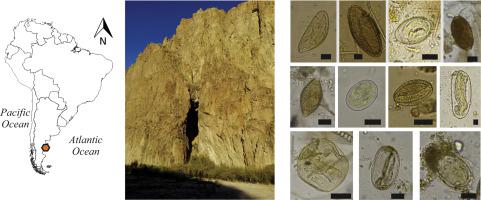Parasitology International ( IF 1.9 ) Pub Date : 2020-05-20 , DOI: 10.1016/j.parint.2020.102147 Eleonor Tietze 1 , Daniela de Tommaso 2 , María Ornela Beltrame 1

|
Parasite remains in micromammal fecal pellets collected from the paleontological site “Cueva Peligro” (CP 43°40′18”S, 66°24′52”W), Chubut Province, Argentina, were examined. The samples were obtained from two grids, dated between 1220 ± 7014C yr B.P. to modern dates. Fecal pellets were whole processed, rehydrated, homogenized, and examined via light microscopy. Eggs of parasites found were measured and photographed. Fecal pellets belong to one or more insectivore to omnivore unidentified micromammal species, possibly sigmodontine rodents. A high number of helminthes species was recorded (11 species), eight nematodes, two anoplocephalid cestodes and one acanthocephalan species. The sigmodontine-parasite relationship varied throughout the studied period and between studied grids. This is the first time that Gongylonema sp. and Syphacia sp. are reported from ancient times from Patagonia. The obtained results contribute to the knowledge of parasite assemblages associated to native South American sigmodontine rodents and the zoonoses present in the area throughout the lasts 1200 years.
中文翻译:

整个新世晚期(“ Cueva Peligro”古生物学站点,阿根廷巴塔哥尼亚)中的微小哺乳动物粪便中的寄生虫。
检查了从阿根廷丘布特省的古生物学场所“ Cueva Peligro”(CP 43°40′18” S,66°24′52” W)收集的微小哺乳动物粪便中的寄生虫残留。样品取自两个网格,日期为BP 1220±70 14 Cyr BP至现代日期。粪便颗粒经过整体处理,再水化,均质并通过光学显微镜检查。测量发现的寄生虫卵并拍照。粪便颗粒属于一种或多种食虫动物,是杂食性未鉴定的微哺乳动物物种,可能是乙草胺鼠。记录到大量的蠕虫种类(11种),8种线虫,2种无头类和1种棘头目。在研究的整个时期以及研究的网格之间,乙二炔-寄生虫之间的关系各不相同。这是第一次Gongylonema SP。和Syphacia sp。是从巴塔哥尼亚(Patagonia)古代报导的。所获得的结果有助于了解与南美本地原始乙二鼠类啮齿动物有关的寄生虫组合以及在过去1200年中该地区存在的人畜共患病。



























 京公网安备 11010802027423号
京公网安备 11010802027423号